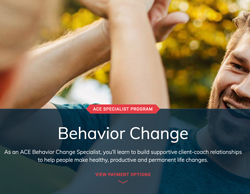
Seventeen years ago, when Tammy Lea Matthews was attempting to lift a heavy object, she suffered an injury to her spine. After trying opioids for pain relief and not liking the side effects, she sought out a new approach.
“I began looking for alternative pain remedies,” Matthews says. “Among others, I found cognitive behavioral therapy techniques. Breathing, self-distraction and visualization work very well for me. I still take a minimal amount of pain medication along with the techniques. Living a healthy lifestyle is key, as well."
Cognitive behavioral therapy (CBT) is a psychosocial intervention that is used to improve mental health. CBT focuses on challenging and changing unhelpful attitudes, thoughts and beliefs, which, in turn, is believed to help with behavior change, coping strategies and emotional regulation.
Although CBT itself is outside of the scope of health coaching, cognitive behavioral coaching (CBC) is certainly within a coach’s scope of practice and a powerful approach to behavior change.
“There are cognitive behavioral coaching strategies based on CBT principles that coaches can present to clients to guide them toward more positive emotions and therefore, more positive behaviors,” explains Karen Woodmansee, MA, MS, an ACE Certified Health Coach, ACE Behavior Change Specialist, and owner of Time for You Wellness, LLC.
“I use CBC techniques regularly with my clients,” acknowledges Karen Nathan, EdM, ACE Certified Health Coach, “especially when we work on weight loss or smoking cessation.”
The editors of the book, Cognitive Behavioral Coaching in Practice: An Evidence Based Approach, define cognitive behavioral coaching as, “A collaborative, goal-directed endeavor, using multimodal learning methods to help individuals develop their capabilities and remove any psychological blocks that interfere with this process.”
“The way individuals perceive a situation is more closely connected to their reaction than the situation itself.”
—Dr. Aaron Beck, developer of cognitive therapy
Restructuring Cognitive Distortions
Like most people, at some point in your life you probably distorted the truth in some way. For example, have you ever had someone give you a short, terse response and automatically think, “What did I do wrong?” or “Why is she mad at me?” only to find out later that her response had nothing to do with you. Turns out she was dealing with a sick child and had had a horrible morning and was simply stressed out.
This is an example of a cognitive distortion. Cognitive distortions are inaccurate thoughts that color our perception and reinforce negative thought patterns, beliefs and emotions. They come in many forms. A few of them include:
- Filtering: Think the opposite of “rose-colored glasses” here. Everything is seen in a negative light, regardless of how much good is right in front of you.
- All-or-nothing/black-and-white mindset: If you don’t have time for your full workout, you don’t exercise. This mindset also emphasizes right and wrong with no gray areas.
- Jumping to conclusions: This involves the tendency to jump to conclusions without any real evidence.
- Blaming: It’s always someone else’s fault for your actions and feelings. Someone with this type of distortion doesn’t take responsibility for his or her behavior.
- Always being right: Someone who falls into this distortion believes they must always be right and that being wrong is unacceptable, to the point that being right is more important than other people’s feelings. They also have difficulty admitting they’re wrong or that they made a mistake.
When you, as the coach, are able to help clients identify their cognitive distortions, you can then teach them about strategies to change them. “During the coaching conversation, my clients have the opportunity to examine long-held and often distorted beliefs about their ability to achieve important health behavior change goals,” explains Nathan. “Together, we have proven that just because they see themselves in a negative way, it doesn’t mean that it’s true.”
Cognitive Restructuring
One of the techniques Nathan relies on most is called cognitive restructuring. “I start by helping clients identify cognitive distortions, which I sometimes refer to as ‘thinking mistakes.’ Then, together we devise more helpful responses that allow them to ‘talk back’ to their distortions.”
As examples of distorted thinking, Nathan considers two common areas of behavior change: weight loss and smoking cessation. “A client might have a strongly held belief that he blew his diet over the weekend and, therefore, will never be able to lose weight. Another example of cognitive distortion is the client who believes she is a bad person because she smoked an unplanned cigarette. Both of these cases highlight inaccurate labeling and unhelpful exaggeration,” explains Nathan. “In both instances, the client could benefit from guidance on how to identify and then challenge these thoughts, and that is where cognitive restructuring comes into play.”
Changing the meaning and focus is one way to restructure. “The dieter,” says Nathan, “could rewrite his mental script by reminding himself, ‘Oh well, I ate some unplanned food over the weekend. Now I can focus on getting right back on track. When I follow my eating plan, I am more likely to lose the weight.’ In the case of the smoker, she could say, ‘Of course I’m not a bad person. I just made an unhelpful decision to smoke.’”
“I think one of the most valuable techniques is that of objectively witnessing your life to reframe negative thoughts, events and emotions,” asserts Woodmansee. “By accurately witnessing life’s ups and downs without inflating negative events—or diminishing positive achievements, for that matter—clients can develop an understanding that the events of their lives are within their own control. Reframing events with a positive slant can help diminish negative self-talk that tends to sabotage happiness.”
Reframing
I witnessed a powerful example of this recently in a workshop I taught at a women's health conference. One of my attendees was an experienced therapist who made it clear that she did not need a life coach; she was simply hoping to learn something. In the workshop, I guided participants through a sample coaching session, using specific questions to ultimately uncover their own limiting beliefs and fears. We then tried a CBC technique called “reframing,” in which the phrase “what if” is used to change the meaning of these beliefs. In tears, this therapist asked me to help her reframe her belief that she can’t make herself vulnerable to family members, as she feared it would reveal her as a fraud.
I began, “What if…other family members are afraid to make themselves vulnerable for the same reason? What if…their reaction to you making yourself vulnerable is a positive, empathetic response? What if…you being brave and making yourself vulnerable gives them permission to do the same?” You could see her fear and anxiety lift as I came up with each “what if” statement and she expressed to me later how powerful the process was for her.
Many CBC techniques are simple, yet powerful, as in the reframing exercise just described.
“I also like to play out negative thoughts and events until they are absurd,” adds Woodmansee. “That can be a terrific way to help someone who is swirling in a negative thought cyclone and can’t see the truth of a situation. By making the event much worse, it can suddenly seem silly and ridiculous. When we can laugh at ourselves and the situations that bring us pain or discomfort. That playful lightheartedness can dilute the event until it doesn't have the same power over us.”
The Importance of Gratitude
Woodmansee also likes to keep a gratitude journal, and in fact, several studies have shown how focusing on what you’re thankful for can change the brain. One study, for example, showed that participants who kept a gratitude journal on a weekly basis exercised more regularly, experienced fewer physical symptoms, felt better about their lives as a whole and were more optimistic about the upcoming week compared to those who recorded hassles or neutral life events.
“I think it’s easy to get inside your own head with negative thoughts and get swept out to sea in a riptide of negative thinking,” concludes Woodmansee. “Using CBC techniques, coaches can throw out a life preserver and help a client objectively see an emotion as it truly occurs, the goal of which is to change from a negative to a positive pattern of thought so that transformative positive behavior change will follow.”





 by
by 





